
Rice Paper
Contact
Home

Fiber Used in Rice Paper
Cellulose fiber, the main ingredient of paper, is available in a number of different forms. Think the fact that how papermakers make decision about which plant to use for papermaking among thousands of fiber yielding ones. The criteria is the fiber length, whether the fiber can be easily harvested, and whether the plant grows in large quantities for needs. The fiber-yielding plants listed here are commonly used for papermaking in China, Korea and Japan.
Rice straw
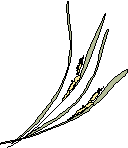 Size 2 - 4 ft. Blades Flat, ligule membranous, 6 - 18 in long on the lowermost leaves, panicle loose, drooping, 3/4 in across, spikelet with a terminal grain-producing floret. Florets Fertile, with two closely appressed sterile scales immediately below.
Size 2 - 4 ft. Blades Flat, ligule membranous, 6 - 18 in long on the lowermost leaves, panicle loose, drooping, 3/4 in across, spikelet with a terminal grain-producing floret. Florets Fertile, with two closely appressed sterile scales immediately below.| Botanical Name | Oryza sativa |
| Plant family | Graminae |
| Fiber length | 1 - 3.5 mm |
| Fiber type | Grass |
| Plant part used | Stem |
| Harvest | After the crop harvested |
| Paper color | White to cream |
| Used in | China, Japan, Korea, India |
Rice has been grown intensively for more than 7,000 years. The crop may be harvested several times per year in some climates. After harvest papermakers cut the stems of rice straw into useable pieces and soak them in clear water for about a day prior to pulping.
Bamboo
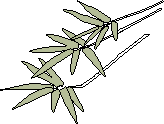 Size 10 - 60 ft. Stem Woody, as much as 2 - 5 in in diameter, D-shaped in cross section, branching at all but the lower nodes, the lowermost nodes densely congested. Leaves Taper-pointed, dark green above, rather stiffish bristles beneath. Flowers Seldom flowering.
Size 10 - 60 ft. Stem Woody, as much as 2 - 5 in in diameter, D-shaped in cross section, branching at all but the lower nodes, the lowermost nodes densely congested. Leaves Taper-pointed, dark green above, rather stiffish bristles beneath. Flowers Seldom flowering. | Botanical Name | Phyllostachys aurea |
| Plant family | Graminae |
| Fiber length | 1 - 5 mm |
| Fiber type | Grass |
| Plant part used | Stem |
| Harvest | Anytime |
| Paper color | Varies from yellow to cream |
| Used in | China |
There are about 1,500 existing species of bamboo divided into about 80 different genera. Bamboo occurs naturally in most countries, including Africa, Pacific Islands and Australia. This most versatile woody plant is part of the everyday life and culture of most of Asia, yet the Western world remains relatively uninterested about it. This is partly because there are no bamboo species in any part of Europe and Middle East. The beauty of using bamboo for making paper is that you do not kill the source of your raw material if harvested in an intelligent way. Each year it will produce new culms, a constantly self-renewing resource. Bamboo is used for papermaking by many countries. India used to make 70 per cent of its paper from bamboo.
Hemp
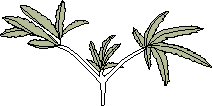 Size 3 - 6 ft. Leaves Coarsely toothed, to 10 in long. Flowers Small and blue.
Size 3 - 6 ft. Leaves Coarsely toothed, to 10 in long. Flowers Small and blue. | Botanical Name | Cannabis sativa |
| Plant family | Moraceae |
| Fiber length | 25 mm |
| Fiber type | Bast |
| Plant part used | Stem |
| Harvest | Fall |
| Paper color | Off-white |
| Used in | China, Japan, Korea |
Still in use to make a strong rice paper today, hemp is an ancient moraceous herb cultivated since 2800 BC. The known earliest example of hemp paper can be dated to 200 BC. Hemp fiber was also the main ingredient of ancient Japanese paper.
Mulberry
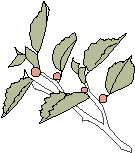 Size 50 ft. Leaves Ovate to broadly ovate, to 8 in long and 6 in across, sometimes lobed, coarsely toothed. Flowers Males white, females green, borne in late spring to early summer. Fruit Red, protruding from a rounded cluster, 3/4 in across.
Size 50 ft. Leaves Ovate to broadly ovate, to 8 in long and 6 in across, sometimes lobed, coarsely toothed. Flowers Males white, females green, borne in late spring to early summer. Fruit Red, protruding from a rounded cluster, 3/4 in across.| Botanical Name | Broussonetia papyrifera |
| Plant family | Moraceae |
| Fiber length | 10 mm |
| Fiber type | Bast |
| Plant part used | Branches |
| Harvest | Fall |
| Paper color | white (inner bark) |
| Used in | China, Japan, Korea |
Fiber of mulberry tree bark was first used for papermaking in the 2nd century. In late fall papermakers cut the tree branches to harvest the bark. This plant produce a semi-absorbent paper.
Wingceltis
 Size 30 - 45 ft. Leaves Dark green, heart-shaped, 2 - 4 in long and across, toothed, smooth. Flowers Small and yellow-green.
Size 30 - 45 ft. Leaves Dark green, heart-shaped, 2 - 4 in long and across, toothed, smooth. Flowers Small and yellow-green.| Botanical Name | Pteroceltis tatarinowii |
| Plant family | Moraceae |
| Fiber length | 5 mm |
| Fiber type | Bast |
| Plant part used | Bark |
| Harvest | Fall |
| Paper color | White |
| Used in | China |
Wingceltis is native to South China. Japanese tried to cultivate this plant in Japan, but the transplanted wingceltis only produced weak fiber. To make a fine paper rice straw is mixed with this fiber.
Gampi
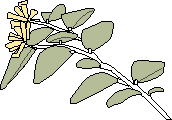 Size 6 ft. Leaves Ovate to elliptic, 4 1/2 in long and 2 1/2 in across, taper-pointed, toothed, dark green above, paler beneath, finely hairy on both sides. Flowers Yellow, fragrant.
Size 6 ft. Leaves Ovate to elliptic, 4 1/2 in long and 2 1/2 in across, taper-pointed, toothed, dark green above, paler beneath, finely hairy on both sides. Flowers Yellow, fragrant.| Botanical Name | Wikstroemia retusa |
| Plant family | Thymelaeaceae |
| Fiber length | 2 - 5 mm |
| Fiber type | Bast |
| Plant part used | Branches |
| Season harvested | Spring |
| Paper color | Cream (inner bark) |
| Used in | Japan |
Gampi is an indigenous shrub to deciduous forests of Japan. Its inner bark produces most lustrous paper in rice paper family. Because it is difficult to cultivate, only wild gampi is harvested. The use of gampi fiber began around Nara period, 710 - 793 AD. Today this paper is mostly used for artwork restoration.
| Rice Paper |
|
About History Fiber Production Make Your Own Sizing |
| Uses |
|
Calligraphy Mounting Painting Relief Printing Rubbing Western Art Kite Paper Cut Lantern Surfboard Window Covering |